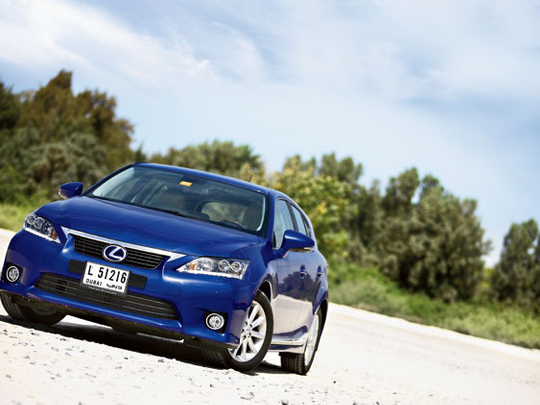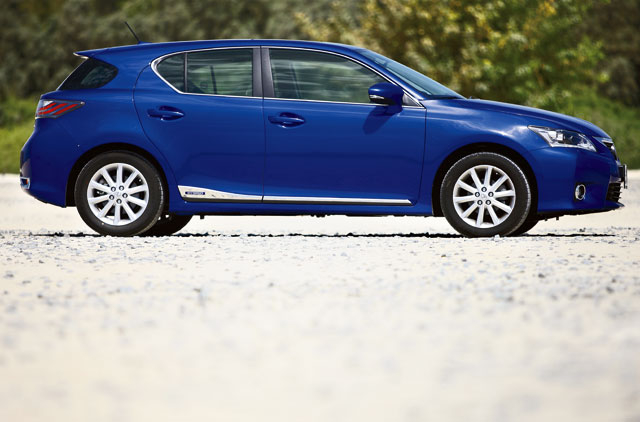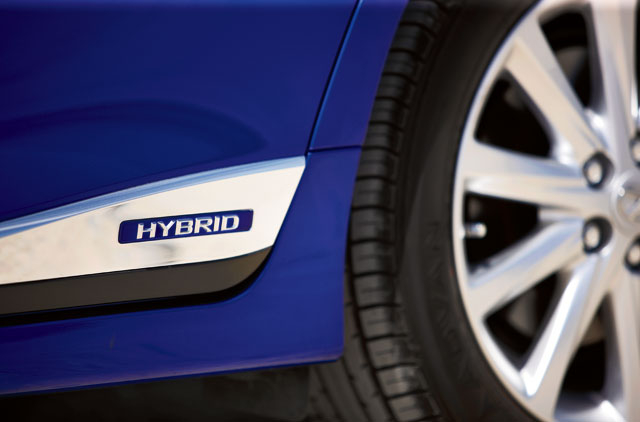
The word luxury conjures up quite a few sumptuous images. An opulent, immaculately crafted cabin awash in soft, supple, fine grain leather and the choicest burl wood panels is probably one of the first to pop into your mind. But, the single most important attribute that defines luxury in anyone's lexicon ought to be space, and lots of it. Luxury isn't exactly luxury without that extra space which allows for a fully reclining airline-like seat in the rear.
Going by that definition, the idea of a compact luxury car does sound self-contradictory. Perhaps, that could well be the reason why you don't see too many of those around. When someone shells out a few hundred grand for a car, they expect more than just a premium badge, some leather and wood. Armed with this knowledge, when Lexus decided to jump on the compact luxury car bandwagon, it came up with a brilliant idea.
Apart from having rear seats that can accommodate regular-sized human beings, they just added an electric motor and a battery to the equation and called it a compact premium hybrid. Moreover, you don't have to pay through the nose to get hold of a CT200h. Aimed at luring more customers, especially youngsters, to the brand, Lexus has priced the car between Dh132,000 and Dh160K.
So at first glance, Toyota's premium brand seems to have got everything right with its first ever hatchback. But, being the doubting Thomases that we are, we decided to put the baby Lexus through a gruelling test covering more than 1,000km over three days.
The styling is essentially Lexus, with smooth, sweeping lines that would not offend anyone. Although it isn't one of the most stimulating hatches to look at, the fact that it reminds one of the VW Scirocco at first sight indeed says a lot about the looks. Inside, the car is unmistakably upmarket and impeccably put together, and surprisingly spacious for the segment. Lexus has gone a step further in being eco-friendly by using bamboo charcoal speakers and energy efficient amplifiers, apart from the use of bio-sourced materials elsewhere in the car.
There's nothing novel about the hybrid powertrain though. The technology is the same that's employed in the flagship LS600h, with the car capable of running in EV mode up to a speed of 40kph and the electric motor also acting as a power generator constantly recharging the NiMH battery by recovering kinetic energy during braking and cruising. At full pelt, the electric motor chips in to add to the 1.8-litre engine's 98bhp output, taking the total to a respectable 134bhp. But the CT200h is not the sportiest of premium hatches around, even in Sport mode. Though being a Lexus, it is arguably the most comfortable in the segment.
However, what we set out to find was whether the hybrid's planet-saving credentials were genuine or just marketing fluff. The thing is that hybrids are the complete opposite of conventional cars that we're used to.
Straining down the highway, as being hybrids they're usually underpowered as well, they struggle to make any noticeable fuel gains. But in city traffic and the daily crawl to work, well that's where they make the difference.
So on the first day, we took it on a 52km trip around the city, starting from Dubai Festival City, through Nad Al Sheba, Al Safa, Jumeirah, Satwa and back to our starting point via Garhoud Bridge. Our average fuel consumption was 7.4 litres-per-100km. Great figure, we thought, but the Lexus had a surprise in store for us.
Funnily enough, and contrary to conventional hybrid wisdom, on a 300km round trip to Abu Dhabi the second day, we averaged an incredible 4.6 litres-per-100km. Of course, it included the morning rush hour traffic in the capital, but the major part of the trip was cruising down the E11 at 100-120kph. And we didn't even annoy any other motorists. Too much…
Satisfied about saving at least one family of endangered aardvarks somewhere in Papua New Guinea, we spent the whole of the third day caning the little 1.8-litre four pot into oblivion and beyond around our patented UAE Nordschleife. The route takes up fast highways with 140kph speed limits, and treacherous twisty bits with plenty of steep hills thrown in to drain even the most resilient of batteries. In Sport mode, the car was almost as slow as in Eco mode, and its CVT was incredibly tedious and uninspiring. But to the car's credit, it must be admitted that despite being thrashed right through our 500km trip on the third day, the fuel economy worsened only into the low sevens. So, after three days and over 1,000km, the average fuel consumption was 5.9 litres-per-100km, which is an absolutely fantastic figure by any standards.
Anyway, we couldn't care less about the sporty thing because after being conditioned into thinking that fuel prices don't matter and that a V8 is better over a V6 any day, the feeling of saving some fuel and challenging ourselves to do it even better was pretty novel. It was like discovering for the first time as a child that you can finally climb that tree in the backyard. Every day you climb that little bit higher.
Verdict
So the thing with the Lexus CT200h is that it's really great, if you understand what it's for. You don't go out and buy a diet cola if what you want is a sugar-rush. Similarly, you won't go out and buy a CT200h if you're after a sportscar. You buy it if you've exhausted yourself and the rest of your family with mind-numbing ‘I spy with my little eye' road trip games, and you want to play the game of ‘Let's see how low we can go'. Saving fuel is fun. You should try it some day.
Specs
Model CT200h
Engine 1.8-litre four-cylinder and electric motor
Transmission Electronic CVT, FWD
Max power 134bhp total output
Max torque 142Nm @ 4,400rpm
Top speed NA
0-100kph NA
Price Dh160,000 as tested
Plus Incredibly fuel efficient, great ride
Minus Not the sportiest hatch















